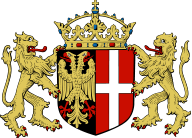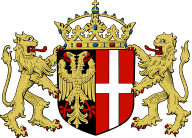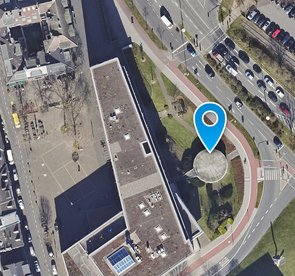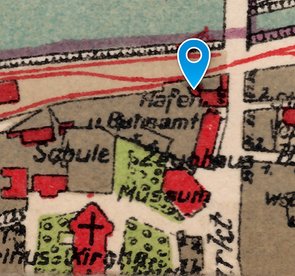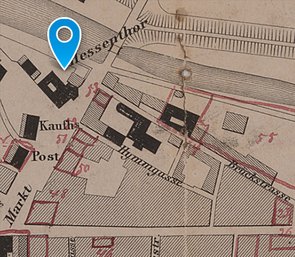-
Audio Guide (Deutsch) -
Audio Guide (Nüsser Platt) – © Vereinigung der Heimatfreunde Neuss e.V.
Kehlturm
Denkmal
Der zu Beginn des 14. Jahrhunderts zusammen mit dem äußeren Stadtmauerring errichtete Kehlturm ist der letzte erhaltene Rundturm der mittelalterlichen Stadtbefestigung. Sein Name leitet sich von der „Kehl“ oder „Kalle“ ab, einem mit der Rheinverlagerung ab dem 12. Jahrhundert entstandenen Rheinarm, der hier aus Richtung Hamm kommend auf den aus der Obererft gespeisten alten Lauf („Erftfluss“ oder „-kanal“) traf. Mit seinen mächtigen, zwei Meter dicken Mauern und einem Durchmesser von zwölf Metern war der Turm ein starkes Bollwerk. Später wurde der massive Turm mit Geschützen ausgestattet. Er diente an der äußeren Stadtmauer als Bastion zum Schutz des unterhalb gelegenen Schiffsanlegeplatzes und der Kehl.
Zu Beginn des 19. Jahrhunderts ging der Turm in den Besitz des benachbarten Alexianerklosters an der Brückstraße über. Nach der Zerstörung des Areals im Zweiten Weltkrieg wurde nur der obere Teil des verschütteten Kehlturms wieder freigelegt. Im Zusammenhang mit dem Neubau des Romaneums und der Freilegung eines Teils der Stadtmauer wurde er 2017 restauriert und der Öffentlichkeit im Rahmen von Führungen zugänglich gemacht. In seinem Inneren befindet sich eine Rekonstruktion eines mittelalterlichen Folterstuhls sowie die Installationen „Aleppo“ und „Guantanamo“ des Neusser Künstlers Wilfried Werbitzky.
Quellen und Texte: Stadtarchiv Neuss
Kehl Tower
Denkmal
The Kehl Tower, built in the early 14th century together with the outer wall ring is the last surviving circular tower of the medieval town fortifications. Its name is derived from the ‘Kehl’ or ‘Kalle’, a branch of the Rhine that originates from the river’s course change from the 12th century onwards. Coming from the direction of Hamm, it met here with the old river course, fed from the Obererft and known as Erft river or Erft canal. With its mighty 2-metre-thick walls and its 12-metre diameter, the tower was a strong bulwark. Later the massive tower was equipped with artillery pieces. At the outer town wall, it serves as a bastion to protect the mooring site below and the Kehl.
In the early 19th century, the tower passed into the possession of the neighbouring monastery of the Alexian Brothers on Brückstrasse. Following the area’s destruction in World War Two, only the upper section of the buried Kehl Tower was uncovered again. In conjunction with the new Romaneum building and the uncovering of part of the town walls, it was restored in 2017 and opened to the public as part of guided tours. It houses a reconstruction of a medieval torture chair as well as the installations “Aleppo” and “Guantanamo” by the Neuss artist Wilfried Werbitzky.
Sources and texts: Neuss municipal archives
Tour du Kehl
Denkmal
Construite au début du XIVe siècle en même temps que l’enceinte extérieure, la tour du Kehl est la dernière tour ronde conservée des fortifications médiévales de la ville. Son nom vient de Kehl ou Kalle, un bras du Rhin créé lors du déplacement du Rhin à partir du XIIe siècle, qui rejoignait ici, en venant de Hamm, l’ancien cours (Erftfluss ou Erftkanal) alimenté par l’Obererft. Avec ses puissants murs de deux mètres d’épaisseur et son diamètre de douze mètres, la tour était un rempart solide. Plus tard, la tour massive a été équipée de canons. Elle servait de bastion à l’enceinte extérieure de la ville pour protéger le côté inférieur de l’embarcadère et le Kehl.
Au début du XIXe siècle, la tour est devenue la propriété du couvent des Alexiens, situé à côté de la Brückstraße. Après la destruction du site pendant la Seconde Guerre mondiale, seule la partie supérieure de la tour de guet ensevelie a été remise au jour. Dans le cadre de la construction du Romaneum et la mise au jour d’une partie des remparts, elle a été restaurée en 2017 et ouverte au public dans le cadre de visites guidées. À l’intérieur se trouve une reconstitution d’une chaise de torture médiévale ainsi que les œuvres « Aleppo » et « Guantanamo » de l’artiste Wilfried Werbitzky de Neuss.
Sources et texte : archives de la ville de Neuss
Bilder
-
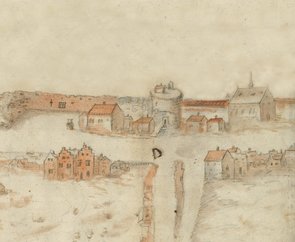
Blick auf die Brückstraße mit dem dahinter liegenden Kehlturm; Zeichnung, 17. Jahrhundert -
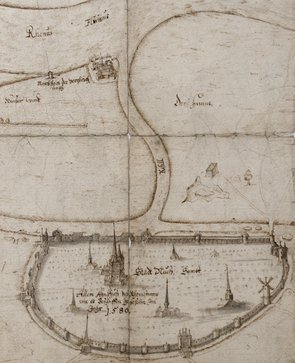
Befestigung der Stadt Neuss mit Zufluss der Kehl vom Rhein; Manuskriptplan, 17. Jahrhundert -
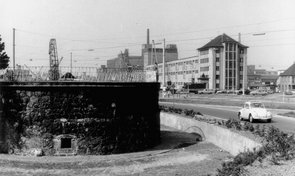
Der freigelegte Kehlturm mit dem Zollamt am Hafenbecken 1 (heute: Haus am Pegel) im Hintergrund, um 1965 -
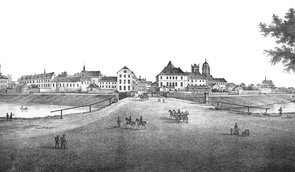
Ansicht der Stadt Neuss von Osten, links außen der Kehlturm vor der Bebauung an der Brückstraße; Lithographie, um 1850 -
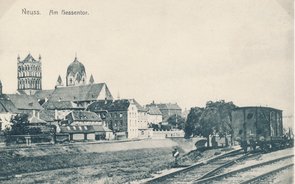
Blick auf die Stadt Neuss mit Quirinusmünster, Zeughaus und Hessentorbrücke (vom Erftkanal aus), links oberhalb des Erftkanals der Kehlturm; Postkarte, um 1920
Downloads
-
Deutsch
Infotafel „Kehlturm“
-
English
Info Panel “Kehl Tower”
-
Français
Plaquette « Tour du Kehl »
